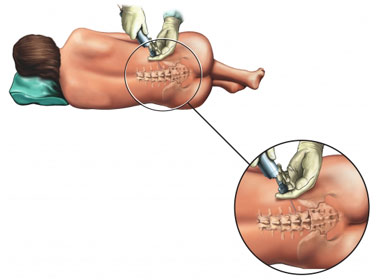Spinalynaya and эpiduralynaya anesthesia
Description of spinal and epidural anesthesia
Spinal and epidural anesthesia are used for the body from the chest down. The medicine is injected directly into the spine area.
Causes the use of spinal and epidural anesthesia
Spinal and epidural anesthesia is often used:
- In operations pelvis, hips and legs;
- At childbirth.
The benefits of these types of anesthesia:
- Ability to be awake during the operation;
- The risk of complications following, than with general anesthesia.
Possible complications of spinal and epidural anesthesia
Complications are rare, but the procedure does not guarantee the absence of risk. If you plan to spinal or epidural anesthesia, you need to know about possible complications, which may include:
- Severe headache or back pain;
- Drop in blood pressure;
- Nerve Damage;
- Infection;
- An allergic reaction to the anesthesia;
- Long childbirth (эpiduralynaya anesthesia);
Some factors, that may increase the risk of complications:
- Smoking;
- Blood clotting;
- Previous allergic reaction to the anesthetic;
- Dehydration;
- Disorders of the immune system.
We need to discuss these risks with your doctor before surgery.
How is spinal and epidural anesthesia?
Preparation for the procedure
Give your doctor the following:
- For information about allergies to medications;
- List of drugs, that you take;
- Information on the diseases of the heart or lungs;
- Data on previous adverse reaction to anesthesia, that was you and other family members;
- For information about problems with excessive bleeding last.
Procedure Spinal and epidural anesthesia
You will be connected to different devices, that will track:
- Blood pressure;
- Pulse;
- The oxygen content in the blood.
It can also be used:
- Venous Catheter for the introduction of liquids;
- Catheter into the bladder to drain urine.
The area of administration of the anesthetic on the back near the spinal cord will be treated with an antiseptic. The skin will put a local anesthetic. This should reduce the pain of the needle, which is incorporated in the back.
If you use spinalynaya anesthesia, the doctor will make you one injection of anesthetic. The medicine will be sent directly to the fluid, that surrounds the spinal cord.
If you use эpiduralynaya anesthesia, for administration of the anesthetic can also be used the above method. But, If to be administered more than one dose of the anesthetic, in the area near the spine with a thin needle is installed, flexible tube. This will allow the doctor to introduce an additional dose of the anesthetic. After operation, at the site of the needle will be placed bandage.

Immediately after spinal and epidural anesthesia
After spinal anesthesia, you may be asked to stay in bed for a few hours. This is to prevent headaches.
Also after spinal or epidural anesthesia will need to stay in bed, until the anesthesia wears off.
How long will the spinal and epidural anesthesia?
Introduction of spinal or epidural anesthesia usually takes about 15 minutes.
- Spinal anesthesia takes effect immediately after injection;
- Epidural anesthesia takes effect later 10-20 minutes after administration.
Spinalynaya and эpiduralynaya anesthesia – Will it hurt?
You will feel some pain during insertion of the needle.
The average time of stay in the hospital after the application of spinal and epidural anesthesia
The residence time depends on the type of operation.
Care after spinal or epidural anesthesia
Care in a hospital
If you used an epidural, tube may be retained for subsequent drug delivery. When anesthesia is no longer needed, the doctor will remove the tube.
Home Care
After returning home, follow these steps:, to ensure the normal recovery:
- First 24 o'clock:
- Do not drive or operate machinery;
- Do not drink alcohol;
Be sure to follow your doctor's instructions.
Contact your doctor after spinal or epidural anesthesia
After returning home, you need to see a doctor, If the following symptoms:
- Signs of infection, including fever and chills;
- Persistent or severe headache or back pain;
- Dizziness, swoon;
- Weakness, numbness or tingling in the hands or feet;
- Urinary bladder or intestine;
- Skin rash;
- Labored breathing.
